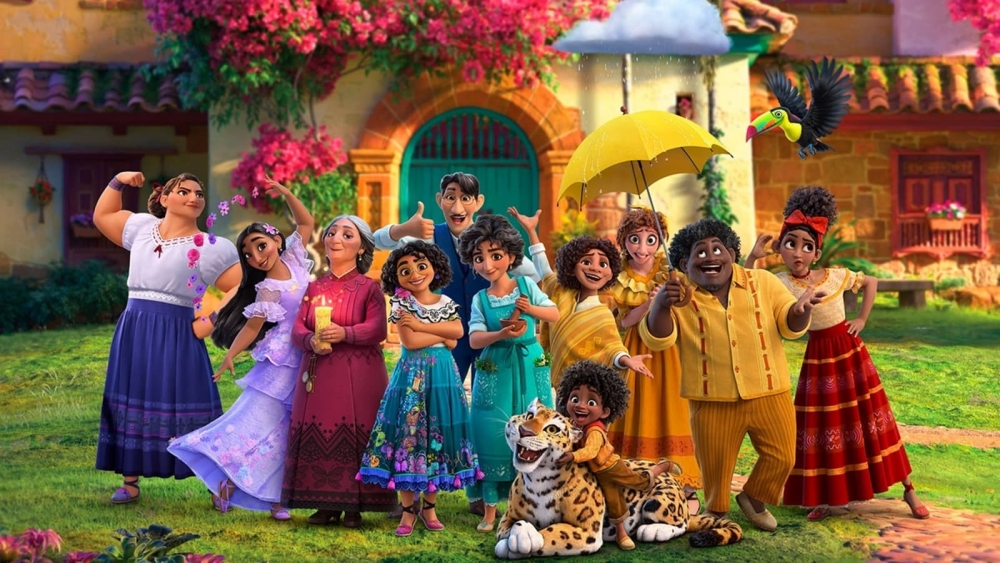
Art Reflects Life

Researchers are always looking for vivid ways to illustrate their findings. This can be a challenge, but for her latest study, Elizabeth Ackert, an assistant professor of geography at UC Santa Barbara, has gotten help from Hollywood.
Two films nominated this year for multiple Academy Awards — “Encanto” and “West Side Story” — dramatize the dynamics of familismo, a family-centric approach to life that is particularly pronounced in the Latino community. In a study published in the Journal of Marriage and Family, Ackert and her colleague, Jocelyn Wikle of Brigham Young University, reveal that teenage Latinas in the U.S. spend far more time with parents and siblings than their Black or white counterparts.
To their surprise, they found this tendency to be prevalent among Latinas with both immigrant and non-immigrant parents. Moreover, it persisted even after Ackert and Wilke took into account a range of factors that might influence such behavior, including family income and parents’ education. This suggests that familismo attitudes and values may influence behavior even in families where every member of the household was born and raised in the U.S.
“In the U.S., teenagers typically start pulling away from their families,” Ackert noted. “They start spending more time alone and with their peers. We wanted to see if that was happening among all subgroups, especially given evidence of familismo among Latinos in other studies.”
To do so, they analyzed data from the American Time Use Survey, a unique yearly undertaking in which a representative group of Americans are asked detailed questions about how they spent their last 24 hours — and who they spent it with. The researchers looked at data from 2003 to 2015, focusing on 9,500 surveys taken by boys and girls ages 15 to 18.
Their findings found major differences between members of different gender and racial/ethnic groups.
“Girls in general spend more time with their families than boys — that’s true of all the racial/ethnic groups we looked at — but Latina girls were spending quite a bit more time with nuclear family members than their Black or white counterparts,” Ackert said. “In the adjusted models, they were spending about 3.2 hours a day with their parents and about 3.8 hours a day with their siblings. For Black and white girls, the figures were 2.4 to 2.85 hours a day with parents, and no more than 3 hours a day with siblings.”
These differences were due in part to the fact that Latino families tend to be larger than white or Black families in the U.S. But the patterns still held when the researchers took family size into account. So while the difference in family time may partly reflect older Latina teens babysitting their younger siblings, “that can’t be the whole story,” Ackert said.
She points to another aspect of Latino culture known as Marianismo — the notion that a girl is expected to emulate the Virgin Mary and practice self-sacrifice along with sexual purity. “There are expectations (for Latina teens) to stay home, spend time with your family and be helpful — which may or may not include child care,” she said.
To her surprise, Ackert found both of these themes in the animated Disney movie “Encanto,” which she first encountered over the winter break. It focuses on a large Colombian family living in a magical house.
“I have a four-year-old, so I have watched it over and over,” she said. “The first time I saw it, I thought, ‘This is interesting.’ The second time, I pulled out my notebook to note how it tracks with our findings.
“One sister talks about the pressure of being expected to do everything her family asks. Another sister is grappling with the fact her family expects her to marry this guy, even though she doesn’t really want to do so. And they’re all together all the time, for pretty much the whole movie.”
In March, Ackert watched Steven Spielberg’s remake of “West Side Story” — and once again found some of her study’s themes dramatized, this time in Tony Kushner’s screenplay.
One scene features a heated argument between members of a family of Puerto Rican immigrants in 1950s New York City. Bernardo, angry with his sister Maria for dancing with a non-Puerto Rican white boy at a social event, angrily tells her he will not allow such behavior. She insists that “I’m gonna think for myself...” He replies: “You keep away from him... as long as you’re in my house,” concluding, “This is about family.”
“I think this scene exemplifies the tensions that can happen with the idea of duty to and respect for the family versus individualism — or, perhaps when there is conflict about family and gender roles within the family,” Ackert said.
That intense exchange raises the larger question: Are familismo and Marianismo ultimately helpful or harmful for Latina teens?
“There is some evidence showing that familismo can be protective for Latina youth,” Ackert said. “It can have a buffering effect. Having strong family ties and good parental models can really help in the transition to American life. So this can be beneficial for Latina girls.
“But when there’s a mismatch between what the adolescent believes and the parent believes — that is, the adolescent wants to spend more time outside the home and the parent wants them to stick close to the family — that’s associated with worse outcomes for Latina girls.”
Other research suggests this attitude may discourage girls from pursuing higher education. In America, going to a four-year college generally means moving away from home, and Latina teens “may be less apt to pursue higher education if it takes them further from their family,” Ackert said. Latinos are increasingly closing gaps with in college enrollment with non-Latinos — going to college is Maria’s plan in West Side Story — “but they’re more likely to go to a two-year school vs. a four-year college, and to not complete a bachelor’s degree.”
So the issue is complex, and more research will be needed to tease out its long-term effects — and determine whether and when these cultural norms shift as new generations emerge.
“Jocelyn and I are not Latinas, so we can’t truly speak to the lived experiences of the Latina adolescent girls in the sample.” Ackert noted. “We know what we see in the data and are basing our conclusions on the findings from the data and on what past research has found on this topic, but qualitative research is likely needed to provide a richer description of what extra time with family means in the lives of Latina girls.”



